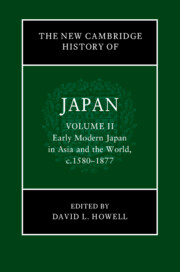Book contents
- The New Cambridge History of Japan
- The New Cambridge History of Japan
- The New Cambridge History of Japan
- Copyright page
- Contents
- Figures
- Maps
- Tables
- Contributors to Volume II
- Preface
- Frontispiece
- Introduction
- Part I The Character of the Early Modern State
- PART II Economy, Environment, and Technology
- 7 International Economy and Japan at the Dawn of the Early Modern Era
- 8 The Tokugawa Economy
- 9 The Pacific Context of Japan’s Environmental History
- 10 Scientific Communities and the Emergence of Science in Early Modern Japan
- 11 The Problem of Western Knowledge in Late Tokugawa Japan
- 12 Technology, Military Reform, and Warfare in the Tokugawa-Meiji Transition
- Part III Social Practices and Cultures of Early Modern Japan
- Index
- References
8 - The Tokugawa Economy
Of Rulers, Producers, and Consumers
from PART II - Economy, Environment, and Technology
Published online by Cambridge University Press: 15 January 2024
- The New Cambridge History of Japan
- The New Cambridge History of Japan
- The New Cambridge History of Japan
- Copyright page
- Contents
- Figures
- Maps
- Tables
- Contributors to Volume II
- Preface
- Frontispiece
- Introduction
- Part I The Character of the Early Modern State
- PART II Economy, Environment, and Technology
- 7 International Economy and Japan at the Dawn of the Early Modern Era
- 8 The Tokugawa Economy
- 9 The Pacific Context of Japan’s Environmental History
- 10 Scientific Communities and the Emergence of Science in Early Modern Japan
- 11 The Problem of Western Knowledge in Late Tokugawa Japan
- 12 Technology, Military Reform, and Warfare in the Tokugawa-Meiji Transition
- Part III Social Practices and Cultures of Early Modern Japan
- Index
- References
Summary
This chapter describes the development of the Tokugawa economy, illustrating how its patterns and shifts were experienced by producers and consumers in a particular place and time. In outlining the framing features of the Tokugawa economic world, we draw attention to how the proportion occupied by manufacturing industries and distribution mechanisms increased steadily in tandem with expansion of the economy’s overall volume. Diverse factors accompanied and further spurred these trends: urbanization (in cities and country towns), greater social mobility, expanding trade and communication networks, rising income, the labor of women as producers for the market, and a popular consciousness increasingly oriented toward ordinary consumption. This economic development can be described in either positive or negative terms. Economic historians in recent decades have pointed more to the positive aspects that raised the standard of living for many, whereas many social historians note the groups who lost out in the commercialization process, such as low-ranking samurai and landless commoners. Evidence can be given for both perspectives, underlining the complexity of what we call economy.
Keywords
- Type
- Chapter
- Information
- The New Cambridge History of Japan , pp. 267 - 295Publisher: Cambridge University PressPrint publication year: 2023



